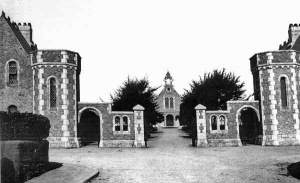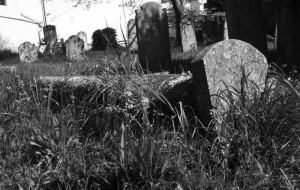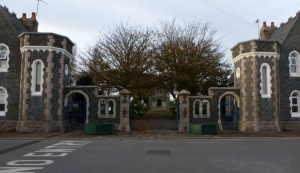St Helier burial grounds
St Helier burial grounds
|
|
This article by Robin Cox was first published in the 1992 Annual Bulletin of La Société Jersiaise
|
Very little is known about the disposal of the dead in the early days of Jersey's history. The Parish of Saint Helier has had three well-documented pouclées or exposed stoneworks, associated with pre-Christian burial:
- On La Montagne de la Ville where Fort Regent now stands
- Towards the bottom of Roseville Street on its west
- La Pouclée Farm, Richmond Road, of which more anon
Of covered pouclées, or hougues, and so known by name to our predecessors, only La Hougue on the Saint John's Main Road and a lesser work, known as La Houguette, existing at the top of New Saint John's Road, and giving its name to a fief in Saint Helier, spring to mind: of the houguette also more anon. Any early adaptation of such sites in St Helier for use by the Christian religion does not seem to have occurred.
I can understand why an abbey (with its attendant burial ground), later reduced to the status of a priory, was built on the Islet in recognition of Saint Helier's role of Christianising the Island, but I do not understand the positioning of the lonely country chapels such as Saint Clair, Notre Dame des Pas and others with their associated cemeteries, traces of which exist. The two town chapels, possibly in a parish enclos are intriguing. The Bretons maintain two buildings in their enclos - a church and a charnel house or ossuary. Is it possible that the second chapel near the limits of each churchyard, as may yet be found in the parishes of St Brelade and St Saviour and evidence of such to be found in St Peter, St Clement, St Martin and St Helier - La Chapelle de la Madeleine - was associated with the reverent storage of bones removed from the limited area of the churchyard prior to the Reformation?
Temporary graves
Is it possible that, apart from the very privileged few, perpetuating the practices of their pre-Christian ancestors in their hougues, who were buried in the confines of the church itself, the ordinary people would be content with a temporary place in the churchyard, say for 12 years, to be reused by others for similar subsequent periods? Some of these ordinary people would seek, perhaps, a long-lasting monument in the form of an obit, an annual prayer in their memory, or a 'light' paid for by a legacy from their estate. With the advent of Protestantism such 'obits' and 'lights' were swept away, with the chapels, as being part of Papist superstition, and the income from them disposed of to the profit of the Crown, the new head of the reformed religion - but the people were now granted permanent burying places with some form of permanent memorial.
How Saint Helier achieved the burial of its parishioners in the churchyard, which has, I agree, been reduced in size for the building of Church House and for a modest road widening, for the next 275 years, without having to take extra land elsewhere, never fails to amaze me, even though all strangers washed, drowned, on to the St Helier beaches were buried only a little way above the high tide mark where they were found.
The Royal Court may have ordered the burial within the confines of a church to cease in 1577, but the very important families seem to have overcome such tiresome controls. It is possible that there lies beneath the flags of St Helier's Church the body of Maximilien Norrys, the Governor's brother-in-law, who died, possibly in Brittany, on 27 November 1591, 400 years ago, fighting for the then Protestant French King, Henry IV, against the Breton-Spanish Catholic League, and whose monument is displayed proudly in the Church.
The south side of the churchyards where, in the northern hemisphere, the shadow of the church never falls, was sought eagerly by the less important families for the interment of their relations. The building of a south aisle and chapel, as additions to St Helier's Church, had taken place before the Reformation because any extensions after the Reformation, if they had been needed, would, upon the insistence of these families, have been built along the north side where only strangers to the parish were buried.
In the 18th century the ideas of the Quakers and Methodists began to appeal to, at first, small numbers of parishioners, but the power of the established Church kept them in check. Being so close to the Royal Square or the beach, St Helier never had to suffer militia drill in its churchyard and, possibly, had more and older permanent vertical monuments than the country parishes whose churchyards served as militia parade grounds until the building of the arsenals.
Changes were imminent. The situation on the Continent had brought war much nearer to the Island and threat of invasion meant the establishment of a large garrison. St Helier housed many hundreds of soldiers in such places as the General Hospital, the Seatonneries, where the Opera House is now, and La Collette. Of their need the Island was made fully aware in 1779 and 1781, when the French attempted to occupy Jersey. The large number of French killed in St Helier during the Battle of Jersey were buried on that part of Meleches Common where Kensington Place now runs.
The French Revolution, however, caused further changes. The parish became flooded with hundreds of French emigrés, the majority of them practising Roman Catholics. To cater for the many deaths among their number and to reserve the Town churchyard for local families and other Protestants, a new cemetery for strangers was laid out on another part of Meleches Common, given by Edward Fiott, the Seigneur. Although it was forbidden to hold Roman Catholic services other than in the house of the deceased and behind closed doors, the new cemetery cannot have failed to have become, in parishioners' eyes, a Roman Catholic cemetery. The acquisition of this new cemetery, therefore, cannot have eased any overcrowding problems experienced in the Town Churchyard.
Royal Court order
By 1825 conditions there were unbearable, the ground level around the Church had risen by many feet but still more coffins were deposited there and had the merest sprinkling of sandy soil to cover them and, on warm days, the smell was abominable. The Royal Court ordered it to be closed and, in 1826, the Parish bought Clos de la Colomberie, named after the Colomb family's residence nearby and, after selling off a part of it to one of its Procureurs de Bien Public for housing, to his personal advantage, laid it out in 999 numbered sepulchres, one each for those families of a certain rate valuation. These sepulchres took four-fifths of the land, the remaining fifth was divided equally between non-rated natives and parish residents who could afford the fees. The cemetery, known to us as Green Street Cemetery, was dedicated and opened on 26 March 1827. An area in the middle was left for the erection of a chapel but, with the increasing power of the dissident religions, this was never so to be and the area was used for later burials for rated families as the town grew in size and was called the Chapel Ground.
The year 1794 had experienced an outbreak of the 'bloody flux' which had been brought to the Island by troops returning from the Low Countries. Many residents died as a result and, in 1832, a worse outbreak of disease, this time of cholera, affected the Island. The Strangers Cemetery or Cimetiere des Mielles had to be closed, through overcrowding, on 11 August 1832, and All Saints Church was built there very soon afterwards. A new burying ground was opened where Westmount Flats and Westmount Court now stand. The old Strangers Cemetery had been acquired by the parish, but had been used for people who had no real connection with the Town: so the parish successfully persuaded the States to purchase the new Strangers Cemetery for use by the whole Island and which, it was decided, would become also a Garrison Cemetery. It was dedicated on 28 August 1832.
Anxious for religious independence, which included reading their own burial service over their dead - for it must be remembered that, at this time and for the next 50 years, the Church of England service had to be read over those being buried in a parochial burying ground - the Quakers purchased and opened a small private ground where part of Patriotic Street Car Park is now; in August 1833 its opening was attended by Elizabeth Fry herself. The Jews followed on 8 February, 1834, when they purchased a small piece of ground to the north of the then new Public Strangers Cemetery.
After a long battle with descendants of those buried in Saint Helier's Churchyard, a law was passed in 1844 allowing it to be reduced in size for the widening of Church Street and Mulcaster Street. This explains why different granite paving slabs were used over what was consecrated ground, for which an annual payment of five shillings was made to the Rector of the Parish. In August 1843 Father Cunningham was buried in the garden of St Mary and St Peter's Church in Vauxhall, of which he was the priest, but his remains were removed to Almorah when later, by 1867, the church was extended. The Reverend Perrot of the Congregational Church purchased a plot of land in April 1846, on the town side of Green Street for the establishment of a dissidents' cemetery, a plan which was not implemented.
By 1850 Green Street Cemetery was beginning to become full and the Parish had to search for alternative sites. Bitter regrets were felt over the sale of the house plots in 1827. Even the ground intended for a chapel had been used for burials, to the satisfaction of the dissidents who had blocked steadfastly all plans for the chapel's erection; as it was to be a Church of England chapel, which they would never use, they, as ratepayers, would not and could not be expected to pay for it. Green Street cemetery has not been without its problems.
Victor Hugo
Apart from the discontent with the parochial disposal of the building plots in 1827 and the persistent obstructiveness of the dissidents over the building of a chapel, the Rector of the time, Philippe Filleul, had to deal with Victor Hugo. On Saturday, 9 April 1853, a French proscrit by the name of du Taillis was buried without the benefit of clergy and this without the knowledge of Mr Filleul. The funeral was turned into a full socialist political demonstration which led to Mr Filleul banning from Green Street all subsequent proscrits' funerals. They used the Macpelah Cemetery in St John from that day onward.
In 1859 Francois Godfray, Seigneur of the Fief of La Fosse, upon which Green Street Cemetery stands, claimed seigneurial rights from the Parish - a small percentage of the price which was paid in 1827. The Parish refused to pay, claiming that the land, by their purchase, had fallen into mortmain and was for the public good. They lost their case in 1864 by abandoning their appeal when it reached the Privy Council.
The dissidents, however, indirectly assisted the Parish in its land problems by buying, in 1854 and 1855, land for their own burying ground at Almorah which included a Clos de la Pouclée. The cemetery was laid out very much in the style of the English Cemetery Companies with meandering paths and weeping trees, and was operated by an association called the Saint Helier General Cemetery. It was opened on 16 March 1854, and was divided into four quarters: the north-west for the Roman Catholics, the north-east for Congregationalists and Baptists, the south-east for Methodists and the south-west for others. In 1854 a collection of fields at the top of Mont Martin which enclosed a Grand Houguette was purchased from the Le Cronier family. However, only half was opened on 16 September 1854, and consecrated on 17 August 1855: the eastern half could not be used until the vendor had reached his majority and had confirmed his tuteur's sale and, therefore, it was not consecrated until 22 September 1863.
The 1832 Strangers Cemetery had become full by this time and a new cemetery at Westmount had been purchased by the States in 1866 and laid out for the Garrison dead and others. The Jews extended their little cemetery westward in 1873 although, soon afterwards, a schism occurred between their principal families and this led to the Leopolds and the Marks families choosing to be buried, until 1929, within a railed enclosure in the south-western part of Almorah. The various Roman Catholic Convents set up in the Island laid out their own burial enclosures within their grounds; of the two situated in St Helier, Hautmont, Mont Millais, and Saint Augustine's, New Saint John's Road, those buried at Hautmont have been reinterred in the north-western part of Almorah, leaving the well maintained cemetery at Saint Augustine's, now the Jeanne Jugan Residence, as the sole survivor in the Island.
Pressure on the new Mont Martin Cemetery was such that the parish had to purchase, in 1880, several fields to the north of the cemetery. These were laid out and opened on 18 March 1881.
The introduction of the practice of cremation in England was hardly noticed by the parish, but the introduction of the Burials Law (Amendment) Act 1880, which was extended to the Channel Islands, signalled the end of the need for the dissident cemeteries. A provision of the law was that no Church of England minister had the right, any longer, to forbid a visiting minister of a different religion from reading his own burial service in the parish burying grounds. Amidst opposition, St Helier's Churchyard lost most of its monuments in 1915 and, six years later, the parish was offered Almorah Cemetery by its owners and took it over in 1921. The parish also had the day-to-day control of the Westmount Strangers Cemetery which, too, as a result of the 1880 Act, ceased to play any major role in the disposal of the parochial dead.
Wartime
It enjoyed a brief period of reuse from 1941 when the Organisation Todt made use of it for the burial of its workers and, from 1942 it was used for those of the German armed forces whom it was considered had disgraced their flag.
Although a crematorium had been opened in Guernsey at their Foulon Cemetery, in 1928, nothing was done here and those who wished for cremation had to cross to Guernsey. As a result, the parish was obliged to purchase more land in June 1947, near the St John parish boundary, which has become Surville Cemetery, consecrated on 27 February 1950. The Quaker Cemetery was sold to Sidney Horman Ltd in 1956 after the bodies there had been exhumed and reburied at La Croix Cemetery, Grouville, which was another former dissidents' cemetery.
Jersey's Crematorium was built on a part of Westmount Strangers Cemetery and dedicated in December 1961, after the bodies of the remaining German dead and of their workers had been exhumed and taken to a large ossuary at Mont-de-Huisnes in Normandy. While cremation for Protestants is a proper and acceptable method of disposal, still more land was purchased, in 1991, for an extension to Surville Cemetery. The Jews, needful of more burying room, purchased from the Parish of St Helier in 1969, a triangular piece of land next to the new Mont à l'Abbé Cemetery. The parish had purchased this land in 1882. The first Jewish burial took place there on 4 June 1982.
In bringing to a close this short talk on the burying places of Saint Helier, the burial of executed criminals in the area of the gallows on Westmount, Mont ès Pendus, and in Bradley's Yard at the prison should not be forgotten. They, perhaps, were the lucky ones for the Royal Court has been known to forbid burial to really wicked criminals whose bodies were condemned to wither and rot in the wind.
- Jersey cemeteries, a further general article on the island's cemeteries
Le Cronier memorial at Green Street Cemetery

























